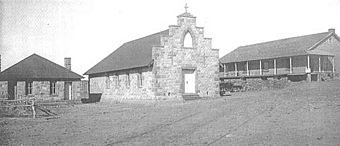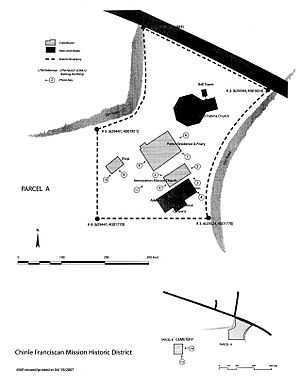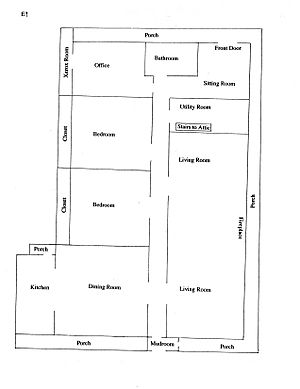Chinle Franciscan Mission Historic District facts for kids
Quick facts for kids |
|
|
Chinle Franciscan Mission Historic District
|
|

The Chinle Mission Compound, ca. 1920s
|
|
| Lua error in Module:Location_map at line 420: attempt to index field 'wikibase' (a nil value). | |
| Location | Indian Service Rte 7, across road and SW of the Chinle Judicial complex and Police Station, Chinle, Arizona |
|---|---|
| Area | 2.92 acres (1.18 ha) |
| Built | 1905 |
| Architect | Weber, Fr. Anselm; et.al. |
| NRHP reference No. | 07000506 |
| Added to NRHP | June 5, 2007 |
The Chinle Franciscan Mission Historic District is a special historical area located in Chinle, Arizona. Chinle is a town within the Navajo Nation. This district is found on the west side of Indian Service Route 7, which is a main road through Chinle.
The historic site covers about 2.92 acres. It is part of a much larger area of 160 acres that the U.S. Federal Government holds in trust for the Navajo people. This land was first set aside for the Franciscan Friars in 1903. Today, the Roman Catholic Church, through the Diocese of Gallup, New Mexico, leases it. The district includes the Our Lady of Fatima Church.
The historic district has three main historic buildings, one historic object, and one historic site. These were built between 1905 and 1925. The buildings are the Friary (where the friars live), the Annunciation Mission Church, and the Workshop/Garage. The historic object is the church bell, made in 1914. The historic site is the church's cemetery, which was used from 1907 to 1935. The district is split into two parts: the main area with the buildings and bell, and a separate area for the cemetery.
Contents
History of the Chinle Mission
The National Park Service says the important historical period for this district was from 1905 to 1956. The Franciscan order first came to Navajo land in 1898, setting up a church and mission in St. Michaels, Arizona. The Chinle Mission was their first outreach from St. Michaels.
In 1902, Father Leopold Ostermann was sent to Chinle to find a good spot for a new mission. At that time, the only permanent buildings in the area were two trading posts. In April 1903, the Navajo people agreed to let the Franciscans build a church and other buildings on land the government had set aside.
The Franciscans arrived in Chinle in 1903. Father Leopold Ostermann held his first church service on September 23. Before that, on June 20, 1903, the United States Secretary of the Interior allowed 160 acres of land to be used by the Roman Catholic Church for missionary and education purposes. Father Ostermann and Brother Placidus Buerger lived in a rented stone building. The local Navajos called Father Ostermann ’Eé’neishoodii Tsoh, which means "Stout Priest."
Building the Mission
The spot for the first building was chosen on August 15, 1905. Work began on the friary (the friars' home) the next day. Local Native Americans did most of the building work, supervised by Brother Buerger and Father Ostermann. Father Anselm Weber, who was in charge at St. Michaels Mission, designed the friary. It was built in 1905 using adobe blocks on a sandstone foundation.
Brother Buerger left in November 1905 because he was very sick and passed away a few months later. Father Ostermann moved into the friary in January 1906, even though it wasn't fully finished. The friary was completed sometime in 1906. Also in 1906, a well was dug, and a windmill was put up. This system used gravity to bring water to the friary. The well was later filled in during the 1940s.
The first baptism at the mission happened on September 12, 1907. The first wedding took place five years later, on April 27, 1912.
Construction on the Annunciation Mission Church began in 1910. A stone post office and an interpreter's house were also built. The mission church was the second oldest Catholic church on the Navajo reservation. It was officially opened on March 25, 1912.
Father Weber ordered the building materials. Many materials came by horse and wagon from Gallup, New Mexico. However, the stone for the cellar and foundation was found nearby. The friary cost about $1500 to build. This rectangular adobe building was first used as both a chapel and the friars' home. Around 1910 or 1911, it became only the friars' residence, which it still is today.
In 1911, a post office was built in Chinle, and Father Leopold became the Postmaster.
A porch was added to the friary in 1912. It was added to over the years and finished in 1940. The cemetery opened in 1912, with the first burial on July 7. In 1914, Reverend Joseph Wernke paid for a bell to be made for the mission. This bell, called the "St. Joseph Bell," was made in Cincinnati, Ohio. It was installed by 1920.
Father Leopold became ill in February 1925. He could only visit the mission sometimes over the next few years. In 1928, he was told to stay at lower altitudes because Chinle is about 4,500 feet high. He passed away on April 10, 1930.
The last of the three important historic buildings was built in 1925. It has been called many names, like "Tool Shop," "Carpenter's Shop," "Ice House," and "Morgue." This is because it was used for different things over the years, including a workshop, a morgue, and a classroom for religious lessons.
In 1934, concrete was added to the foundation of the friary to stop the building from settling. Inside plumbing and a bathroom were also added in May 1934. Two other buildings were improved or built in 1934. An old rabbit house became a coal shed, and an open garage was built behind the friary. In May 1935, a dining room was added to the friary. Later in 1935, on November 11, the mission cemetery became full. The friars then started burying people in a cemetery near the Canyon de Chelly National Monument Visitors Center. Burials continued there until the Chinle Community Cemetery opened on March 30, 1946.
Modern Changes
A new church, made of cinder blocks, was built between August 1, 1959, and March 27, 1960. It was officially opened on March 27 and named in honor of Our Lady of Fátima. At this time, the mission's name officially changed from Annunciation Mission to Our Lady of Fatima Catholic Church. When the new church was finished, the St. Joseph Bell was moved into a tower there.
Major changes were made inside the Annunciation Mission in 1964. The altars were removed, as were the walls that separated the sacristy and sanctuary. The open garage behind the Friary was also torn down.
From 1967 to 1969, more changes were made. The old adobe brick chimney was removed because it was falling apart. The front doorway was made wider. In 1968, a dormer (a window structure) was added to the north side of the building. More remodeling happened from 1976 to 1978. New bedrooms were made by enclosing the screened porch. The existing bedrooms and bathroom were also updated. The rooms upstairs were remodeled, and the dining room and kitchen swapped places and were updated too.
In 1980, a statue of St. Francis was placed in a small alcove next to the front door. A mudroom was also added by the back entrance. A fireplace was added to the south wall of the Friary's living room on December 1, 1981.
In the late 1980s, it was decided to replace the cinder block church built in 1960. The old church was torn down, and a new Hogan-shaped church was built in 1989. The first mass in the new church was held on Christmas Eve, December 24, 1989. In 1999, the Annunciation Mission cemetery was cleaned up and given a new fence. The cross from the old cinder block church was used as the main cross in the refurbished cemetery.
Other Buildings at the Mission
There are other buildings in the historic district that are not considered "historic" by the government's rules. One is the Post Office/Interpreter's House. Even though it was built during the historic period in 1911, it has had additions that hide its original look. If these additions were removed, it might be considered historic again.
Two other important buildings, built after the historic period, are the Our Lady of Fatima Church and the Bell Tower.
Other buildings include a Hogan (a traditional Navajo home) that was brought from Manuelito, New Mexico. There is also a church hall southwest of the Friary. Southeast of the church hall is a thrift shop, which was made by changing an old chicken coop. The church's main offices are in a mobile building, and there are other mobile buildings south of the thrift shop.
Images for kids






